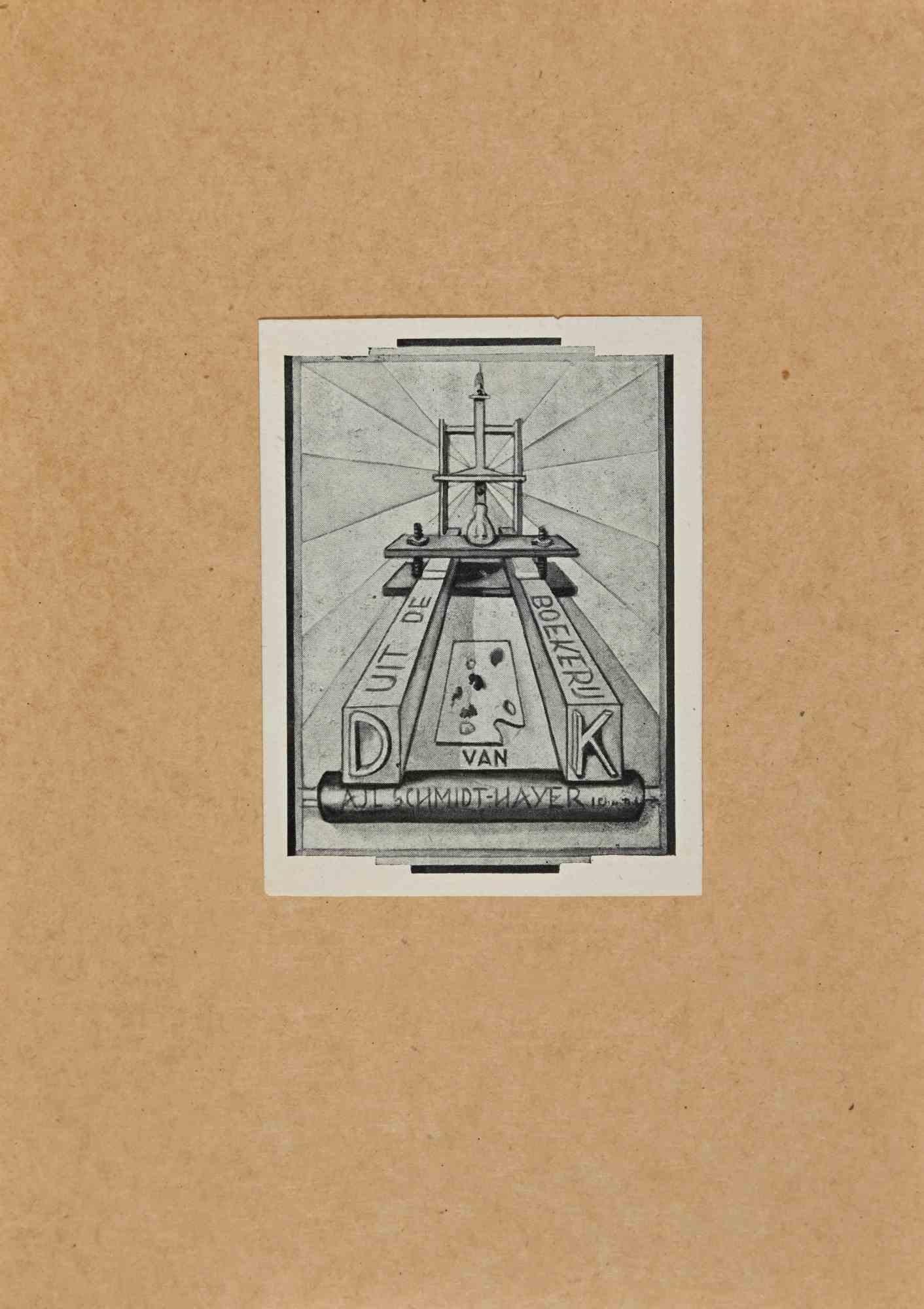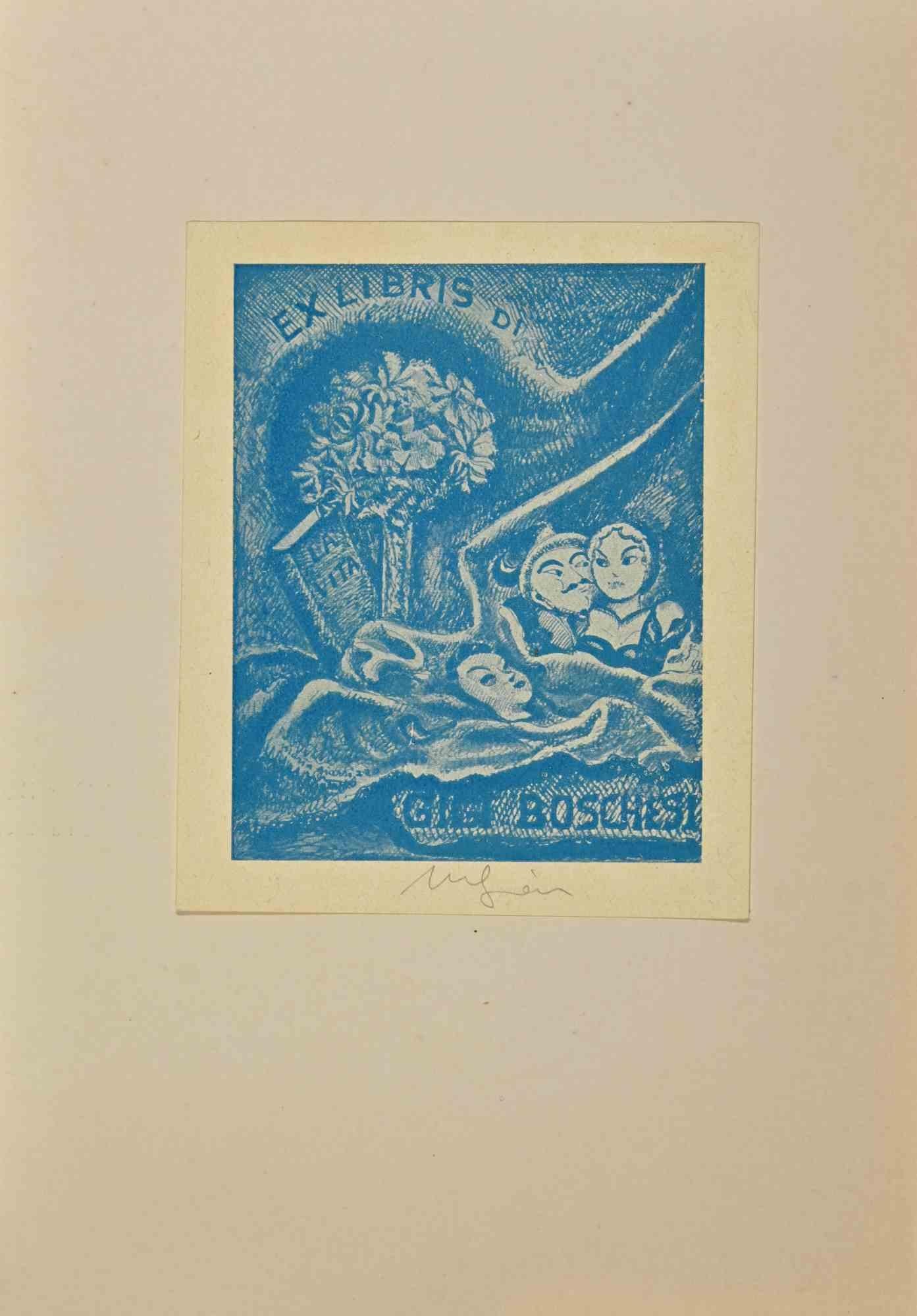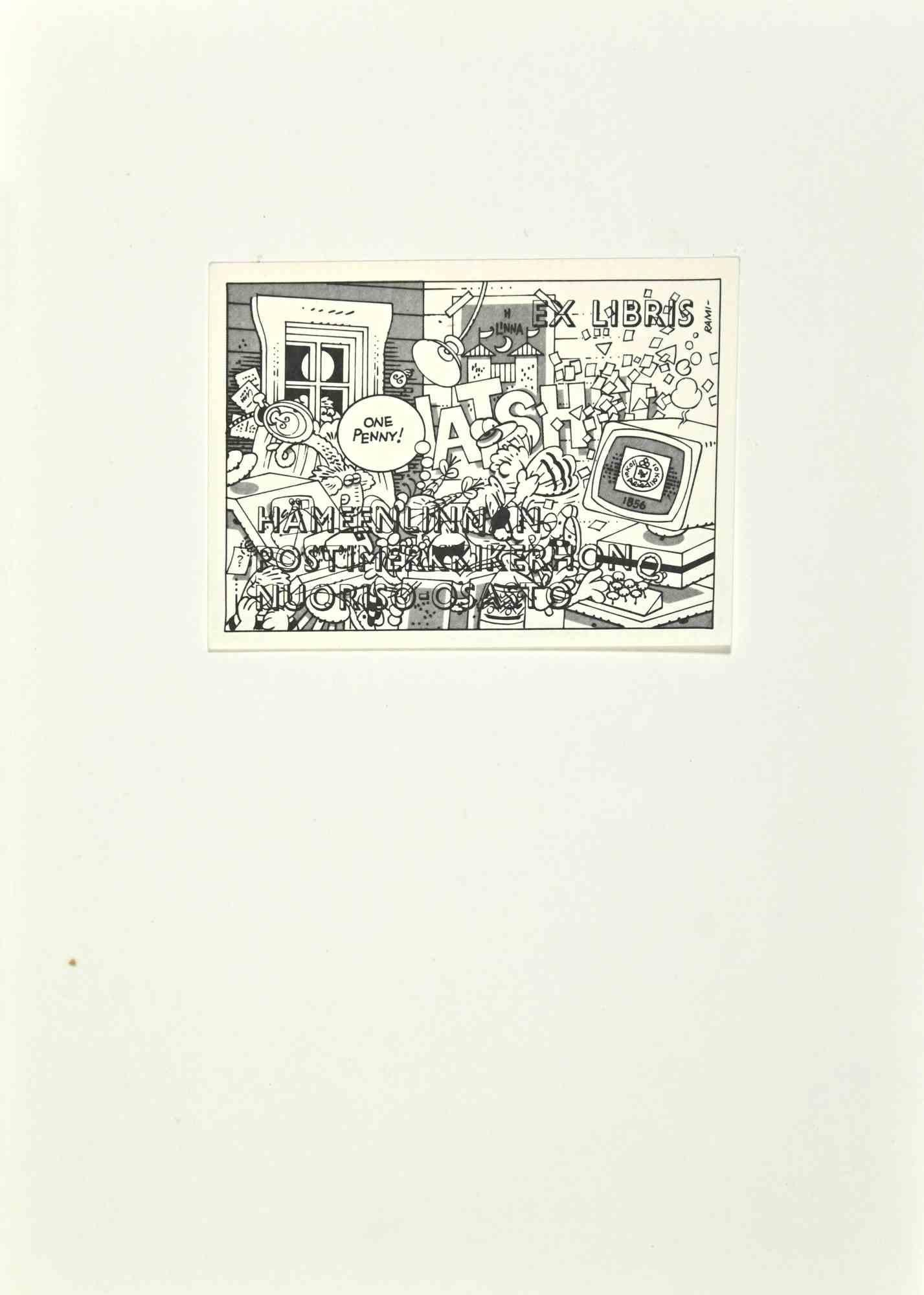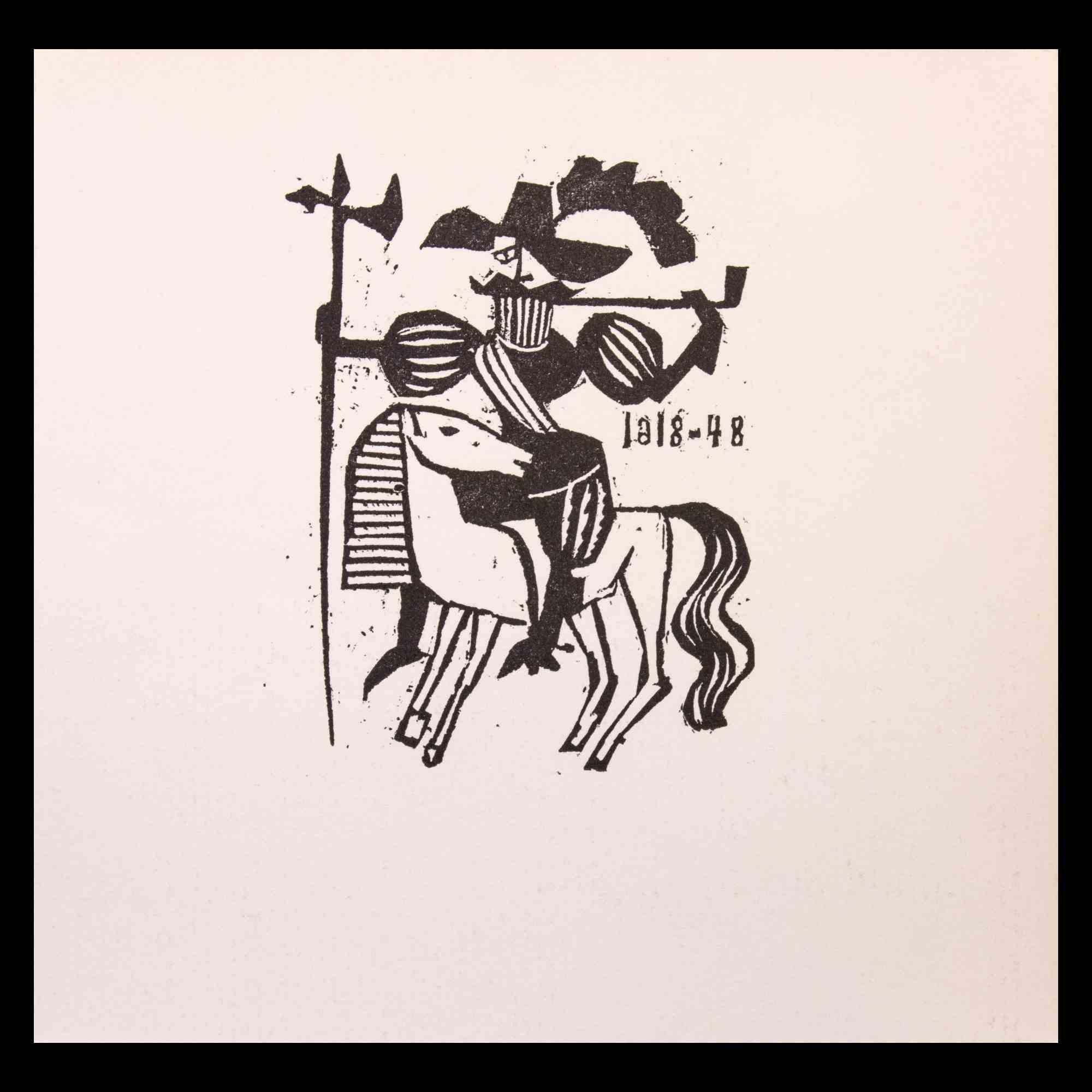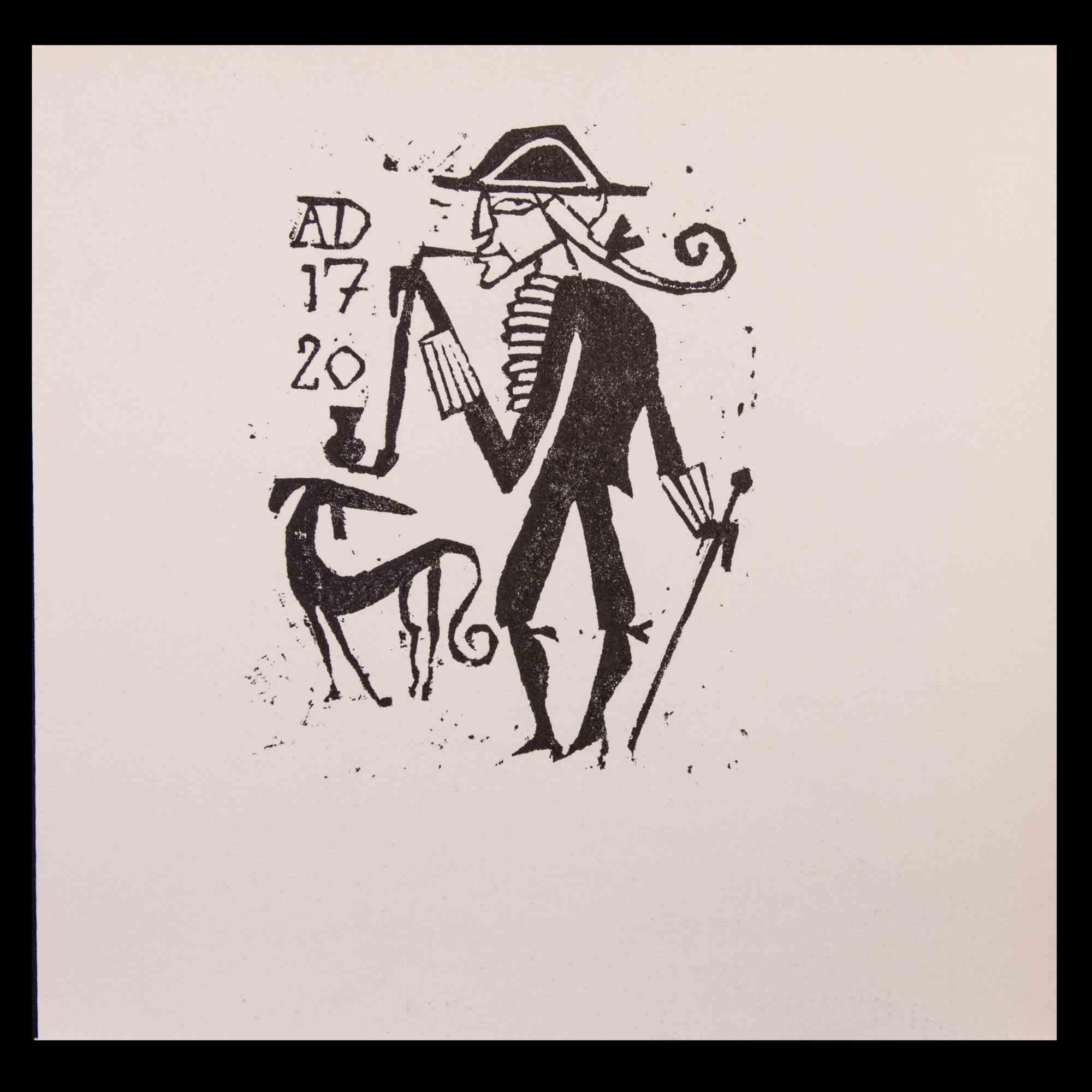Items Similar to Ex-Libris - Navarra - woodcut - Mid 20th Century
Want more images or videos?
Request additional images or videos from the seller
1 of 2
UnknownEx-Libris - Navarra - woodcut - Mid 20th CenturyMid 20th Century
Mid 20th Century
About the Item
Ex-Libris - Navarra is an Artwork realized in Mid 20th Century.
Etching on paper.
Good conditions.
The artwork represents a minimalistic, clean design, through preciseness .
- Creation Year:Mid 20th Century
- Dimensions:Height: 6.7 in (17 cm)Width: 3.94 in (10 cm)Depth: 0.04 in (1 mm)
- Medium:
- Movement & Style:
- Period:
- Framing:Framing Options Available
- Condition:Insurance may be requested by customers as additional service, contact us for more information.
- Gallery Location:Roma, IT
- Reference Number:Seller: T-1436871stDibs: LU650313570962
About the Seller
4.9
Platinum Seller
These expertly vetted sellers are 1stDibs' most experienced sellers and are rated highest by our customers.
1stDibs seller since 2017
6,813 sales on 1stDibs
Typical response time: 3 hours
- ShippingRetrieving quote...Ships From: Monaco, Monaco
- Return PolicyA return for this item may be initiated within 14 days of delivery.
Auctions on 1stDibs
Our timed auctions are an opportunity to bid on extraordinary design. We do not charge a Buyer's Premium and shipping is facilitated by 1stDibs and/or the seller. Plus, all auction purchases are covered by our comprehensive Buyer Protection. Learn More
More From This SellerView All
- Dawn of Glory - Woodcut by Ettore di Giorgio - Early 20th CenturyLocated in Roma, ITDawn of Glory is an Original Woodcut Print on paper realized by Ettore di Giorgio in the Early 20th Century Good Conditions. The artwork is depicted through strong strokes in well-...Category
Early 20th Century Modern Figurative Prints
MaterialsWoodcut
- The Painter - Original Woodcut Print by Max Kurzweill - 1916Located in Roma, ITThe Painter in an original woodcut print realized by Max Kurzweill in 1916. Good conditions. The artwork is depicted through harmonious colors in a well-balanced composition.Category
1910s Modern Figurative Prints
MaterialsWoodcut, Paper
- Portrait - Original Woodcut Print by Mario Vellani Marchi - 1925By Mario Vellani MarchiLocated in Roma, ITThe Portrait is an original Woodcut print realized by Mario Vellani Marchi (1895 – 1979) Good conditions. The artwork is depicted through perfect hatching in a well-balanced compos...Category
1920s Modern Figurative Prints
MaterialsWoodcut, Paper
- Infantryman - Original Woodcut by Gino Barbieri - Early 20th CenturyLocated in Roma, ITInfantryman is an Original Woodcut Print on paper realized by Gino Barbieri in the Early 20th Century Good Conditions. The artwork is depicted through strong strokes in well-balanc...Category
Early 20th Century Modern Figurative Prints
MaterialsWoodcut
- Portrait - Original Woodcut by Sergio Sergi - Early 20th CenturyLocated in Roma, ITPortrait is an Original Woodcut Print on paper realized by Sergio Sergi in the Early 20th Century Good Conditions. The artwork is depicted through strong strokes in well-balanced c...Category
Early 20th Century Modern Figurative Prints
MaterialsWoodcut
- Annunciation - Original Woodcut by Ettore di Giorgio - Early 20th CenturyLocated in Roma, ITAnnunciation is an Original Woodcut Print on paper realized by Ettore di Giorgio in the Early 20th Century Good Conditions. The artwork is depicted through strong strokes in well-b...Category
Early 20th Century Modern Figurative Prints
MaterialsWoodcut
You May Also Like
- Wedding PartyLocated in Buffalo, NYAn original mid century modern woodblock print. This work is hand signed illegibly and titled "Wedding Party".Category
1960s Modern Figurative Prints
MaterialsPaper, Woodcut
- 'City Lights' — Vintage Wood Engraving, New York City, 1934By Fritz EichenbergLocated in Myrtle Beach, SCFritz Eichenberg, 'City LIghts', wood engraving, 1934, edition 200. Signed, titled 'Lights', and annotated 'No 2/200 for Howard M. Chapin' in pencil. Initialed in the block, lower right. A fine, richly-inked black impression, on cream wove paper, with full margins (1 1/4 to 1 7/8 inches); a small loss (5/8 inch) in the top right sheet corner, well away from the image, otherwise in excellent condition. Printed by master printer Ernest Roth...Category
1930s American Modern Figurative Prints
MaterialsWoodcut
- 'Decaying Beauty' —from 'Solitude' for Henry David Thoreau's 'Walden'Located in Myrtle Beach, SCNaoko Matsubara, 'Decaying Beauty' for the portfolio 'Solitude', color woodcut, 1971, edition 100. Signed and numbered '49/100' in pencil. A fine, fres...Category
1970s Modern Figurative Prints
MaterialsWoodcut
- 'The Wolf and the Little Kids' — Graphic ModernismBy Fritz EichenbergLocated in Myrtle Beach, SCFritz Eichenberg, 'The Wolf and the Little Kids' from the suite 'Fables with a Twist', wood engraving, 1975-76, artist's proof apart from the edition of c. 50. Signed, titled, and annotated 'Artist’s Proof' in pencil. Signed in the block, lower right. A fine, richly-inked impression, on cream wove paper, with full margins (7/8 to 1 1/2 inches), in excellent condition. Complete with vellum folder with descriptive text in red and black linotype. Printed by master printer Harold McGrath at The Gehenna Press, Northampton, MA. Image size 13 15/16 x 12 1/8 inches (354 x 308 mm); sheet size 16 1/2 x 14 inches (419 x 356 mm). Archivally sleeved, unmatted. Collection: Harvard Museums. ABOUT THE ARTIST Fritz Eichenberg (1901–1990) was a German-American illustrator and arts educator who worked primarily in wood engraving. His best-known works were concerned with religion, social justice, and nonviolence. Eichenberg was born to a Jewish family in Cologne, Germany, where the destruction of World War I helped to shape his anti-war sentiments. He worked as a printer's apprentice and studied at the Municipal School of Applied Arts in Cologne and the Academy of Graphic Arts in Leipzig, where he studied under Hugo Steiner-Prag. In 1923 he moved to Berlin to begin his career as an artist, producing illustrations for books and newspapers. In his newspaper and magazine work, Eichenberg was politically outspoken and sometimes wrote and illustrated his reporting. In 1933, the rise of Adolf Hitler drove Eichenberg, who was a public critic of the Nazis, to emigrate with his wife and children to the United States. He settled in New York City, where he lived most of his life. He worked in the WPA Federal Arts Project and was a member of the Society of American Graphic Artists. In his prolific career as a book illustrator, Eichenberg portrayed many forms of literature but specialized in works with elements of extreme spiritual and emotional conflict, fantasy, or social satire. Over his long career, Eichenberg was commissioned to illustrate more than 100 classics by publishers in the United States and abroad, including works by renowned authors Dostoyevsky, Tolstoy, Charlotte and Emily Brontë, Poe, Swift, and Grimmelshausen. He also wrote and illustrated books of folklore and children's stories. Eichenberg was a long-time contributor to the progressive magazine The Nation, his illustrations appearing between 1930 and 1980. Eichenberg’s work has been featured by such esteemed publishers as The Heritage Club, Random House, Book of the Month Club, The Limited Editions Club, Kingsport Press, Aquarius Press, and Doubleday. Raised in a non-religious family, Eichenberg had been attracted to Taoism as a child. Following his wife's unexpected death in 1937, he turned briefly to Zen Buddhist meditation, then joined the Religious Society of Friends in 1940. Though he remained a Quaker until his death, Eichenberg was also associated with Catholic charity work through his friendship with Dorothy Day...Category
1970s American Modern Figurative Prints
MaterialsWoodcut
- 'A Visit to the King of the Waters' — Graphic ModernismBy Fritz EichenbergLocated in Myrtle Beach, SCFritz Eichenberg, 'A Visit to the King of the Waters' from the suite 'The Adventurous Simplicissimus', wood engraving, 1977, artist's proof apart from the edition of 50. Signed in pencil. Signed in the block, lower right. A fine, richly-inked impression, on cream wove paper, with full margins (1 1/2 to 2 inches), in excellent condition. Image size 14 x 12 inches (356 x 305 mm); sheet size 17 1/2 x 15 inches (445 x 381 mm). Archivally sleeved, unmatted. ABOUT THIS WORK 'Simplicius Simplicissimus' (German: Der abenteuerliche Simplicissimus Teutsch) is a picaresque novel of the lower Baroque style, written in five books by Hans Jakob Christoffel von Grimmelshausen published in 1668, with the sequel Continuatio appearing in 1669. The novel is told from the perspective of its protagonist Simplicius, a rogue or picaro typical of the picaresque novel, as he traverses the tumultuous world of the Holy Roman Empire during the Thirty Years' War. Raised by a peasant family, he is separated from his home by foraging dragoons. He is adopted by a hermit living in the forest, who teaches him to read and introduces him to religion. The hermit also gives Simplicius his name because he is so simple that he does not know his own name. After the death of the hermit, Simplicius must fend for himself. He is conscripted at a young age into service and, from there, embarks on years of foraging, military triumph, wealth, prostitution, disease, bourgeois domestic life, and travels to Russia, France, and an alternate world inhabited by mermen. The novel ends with Simplicius turning to a life of hermitage, denouncing the world as corrupt. ABOUT THE ARTIST Fritz Eichenberg (1901–1990) was a German-American illustrator and arts educator who worked primarily in wood engraving. His best-known works were concerned with religion, social justice, and nonviolence. Eichenberg was born to a Jewish family in Cologne, Germany, where the destruction of World War I helped to shape his anti-war sentiments. He worked as a printer's apprentice and studied at the Municipal School of Applied Arts in Cologne and the Academy of Graphic Arts in Leipzig, where he studied under Hugo Steiner-Prag. In 1923 he moved to Berlin to begin his career as an artist, producing illustrations for books and newspapers. In his newspaper and magazine work, Eichenberg was politically outspoken and sometimes wrote and illustrated his reporting. In 1933, the rise of Adolf Hitler drove Eichenberg, who was a public critic of the Nazis, to emigrate with his wife and children to the United States. He settled in New York City, where he lived most of his life. He worked in the WPA Federal Arts Project and was a member of the Society of American Graphic Artists. In his prolific career as a book illustrator, Eichenberg portrayed many forms of literature but specialized in works with elements of extreme spiritual and emotional conflict, fantasy, or social satire. Over his long career, Eichenberg was commissioned to illustrate more than 100 classics by publishers in the United States and abroad, including works by renowned authors Dostoyevsky, Tolstoy, Charlotte and Emily Brontë, Poe, Swift, and Grimmelshausen. He also wrote and illustrated books of folklore and children's stories. Eichenberg was a long-time contributor to the progressive magazine The Nation, his illustrations appearing between 1930 and 1980. Eichenberg’s work has been featured by such esteemed publishers as The Heritage Club, Random House, Book of the Month Club, The Limited Editions Club, Kingsport Press, Aquarius Press, and Doubleday. Raised in a non-religious family, Eichenberg had been attracted to Taoism as a child. Following his wife's unexpected death in 1937, he turned briefly to Zen Buddhist meditation, then joined the Religious Society of Friends in 1940. Though he remained a Quaker until his death, Eichenberg was also associated with Catholic charity work through his friendship with Dorothy Day...Category
1970s American Modern Figurative Prints
MaterialsWoodcut
- 'Simplicius' Farewell to the World' — Graphic ModernismBy Fritz EichenbergLocated in Myrtle Beach, SCFritz Eichenberg, 'Simplicius’ Farewell To The World' from the suite 'The Adventurous Simplicissimus', wood engraving, 1977, artist's proof apart from the edition of 50. Signed in pencil. Signed in the block, lower right. A fine, richly-inked impression, on cream wove paper, with full margins (1 1/2 to 2 inches), in excellent condition. Image size 14 x 12 inches (356 x 305 mm); sheet size 17 1/2 x 15 inches (445 x 381 mm). Archivally sleeved, unmatted. ABOUT THIS WORK 'Simplicius Simplicissimus' (German: Der abenteuerliche Simplicissimus Teutsch) is a picaresque novel of the lower Baroque style, written in five books by Hans Jakob Christoffel von Grimmelshausen published in 1668, with the sequel Continuatio appearing in 1669. The novel is told from the perspective of its protagonist Simplicius, a rogue or picaro typical of the picaresque novel, as he traverses the tumultuous world of the Holy Roman Empire during the Thirty Years' War. Raised by a peasant family, he is separated from his home by foraging dragoons. He is adopted by a hermit living in the forest, who teaches him to read and introduces him to religion. The hermit also gives Simplicius his name because he is so simple that he does not know his own name. After the death of the hermit, Simplicius must fend for himself. He is conscripted at a young age into service and, from there, embarks on years of foraging, military triumph, wealth, prostitution, disease, bourgeois domestic life, and travels to Russia, France, and an alternate world inhabited by mermen. The novel ends with Simplicius turning to a life of hermitage, denouncing the world as corrupt. ABOUT THE ARTIST Fritz Eichenberg (1901–1990) was a German-American illustrator and arts educator who worked primarily in wood engraving. His best-known works were concerned with religion, social justice, and nonviolence. Eichenberg was born to a Jewish family in Cologne, Germany, where the destruction of World War I helped to shape his anti-war sentiments. He worked as a printer's apprentice and studied at the Municipal School of Applied Arts in Cologne and the Academy of Graphic Arts in Leipzig, where he studied under Hugo Steiner-Prag. In 1923 he moved to Berlin to begin his career as an artist, producing illustrations for books and newspapers. In his newspaper and magazine work, Eichenberg was politically outspoken and sometimes wrote and illustrated his reporting. In 1933, the rise of Adolf Hitler drove Eichenberg, who was a public critic of the Nazis, to emigrate with his wife and children to the United States. He settled in New York City, where he lived most of his life. He worked in the WPA Federal Arts Project and was a member of the Society of American Graphic Artists. In his prolific career as a book illustrator, Eichenberg portrayed many forms of literature but specialized in works with elements of extreme spiritual and emotional conflict, fantasy, or social satire. Over his long career, Eichenberg was commissioned to illustrate more than 100 classics by publishers in the United States and abroad, including works by renowned authors Dostoyevsky, Tolstoy, Charlotte and Emily Brontë, Poe, Swift, and Grimmelshausen. He also wrote and illustrated books of folklore and children's stories. Eichenberg was a long-time contributor to the progressive magazine The Nation, his illustrations appearing between 1930 and 1980. Eichenberg’s work has been featured by such esteemed publishers as The Heritage Club, Random House, Book of the Month Club, The Limited Editions Club, Kingsport Press, Aquarius Press, and Doubleday. Raised in a non-religious family, Eichenberg had been attracted to Taoism as a child. Following his wife's unexpected death in 1937, he turned briefly to Zen Buddhist meditation, then joined the Religious Society of Friends in 1940. Though he remained a Quaker until his death, Eichenberg was also associated with Catholic charity work through his friendship with Dorothy Day...Category
1970s American Modern Figurative Prints
MaterialsWoodcut
Recently Viewed
View AllMore Ways To Browse
Long Vertical Wall Art
Marc Chagall Black And White Print
Roland Originals
The Pharmacist
Vintage Italian Organ
19th Century Lithographs Woman
Book Of Prayers
Chagall Stained Glass
Female Nude Etching
Poster Jazz Vintage
Sandro Artist
Sandro Vintage
St Michael Vintage
Versailles Garden Painting
Vintage Aesthetic Posters
Vittorio Emanuele
Warhol Gallery Poster
80s Lithograph
